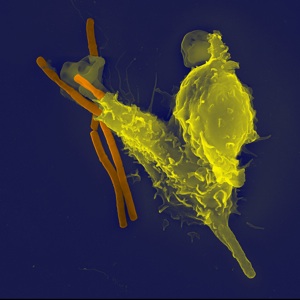
Encyclopedia: Immune System
The immune system is composed of white blood cells, the proteins they produce, and their actions in defending the body.
The innate immune system is in place to combat new threats, while the adaptive immune system is developed against specific, previously encountered threats.
The bulk of the immune system originates in the bone marrow. Groups of lymphocytes are found in the: peripheral lymph nodes, tonsils, Peyer's patches, and other locations.
The spleen is another central immune tissue, involved in surveillance. The thymus is important in early T cell development.
Cells and Molecules of the immune system
- innate immune system
- adaptive immune system
Innate Immune System
Innate immunity provides the first line of defense against infection. Most of its components are present before infection and represent a set of disease-resistance mechanisms that are not specific to particular threats.
The skin provides a mechanical barrier of entry of microbes, while its low pH (3-5) slows microbial growth. Mucous membranes are covered with normal flora that competes with pathogens, while mucus traps organisms and cilia propel them from the body. Temperature and various soluble and cell-surface molecules contribute to innate immunity by impeding the growth of certain pathogens.
Inflammation is a key innate response to invasion. The systemic, or acute phase response, includes fever and release of serum proteins to increase host immunity.
Phagocytic cells are responsible for ingesting pathogens and debris.
- neutrophils: the first line of defence against pathogens
- macrophages/monocytes: other phagocytic cells, responsible for ongoing clearing of pathogens and debris.
Other important cells of the innate immune system include:
- mast cells
- eosinophils
Many of the molecules involved in innate immunity use pattern recognition to detect classes of molecules found on pathogens, such as lipopolysaccharides.
Opsonization refers to the binding of molecules such as immunglobulins or complement fragments (ie C3b) to microbes, enhancing their phagocytosis.
Mast Cells
Mast cells are important mediators of the allergic response.
They release vasoactive mediators, such as histamine and cytokines.
They also release growth factors such as PDGF and proteases, triggering smooth muscle proliferation. This is important in asthma airway remodeling.
Eosinophils
All content about these cells should go here initially..
Adaptive immune system
Adaptive immunity is responsible for the selective recognition and elimination of pathogens and molecules the body has previously seen. It is characterized by antigen specificity, diversity, immunologic memory, and self/non-self recognition.
An effective response involves two cell types - lymphocytes and antigen presenting cells.
Antigen-presenting cells include:
- dendritic cells
Lymphocytes are responsible for developed immunity. Lymphocytes continually circulate throughout the blood, lymph, and lymphoid organs, making a complete circuit as much as 1-2 times daily.
Lymphocytes spend approximately 30 minutes in the bloodstream and end up in either the spleen or various peripheral lymph nodes, where they remain for 5-10 hours.
About 10% of lymphocytes leave the circulation through venules and migrate to extralymphoid tissues that are in contact with the external environment, such as the skin, various mucosal surfaces, and the pulmonary and urogenital tracts.
Continual lymphocyte recirculation maximizes the chances that antigenically committed lymphocytes will encounter antigen.
Leukocyte Trafficking
Different subsets of lymphocytes migrate differentially into different tissues in a process called trafficking, or homing. This is mediated by unique combinations of CAMs, chemokines, and receptors. Trafficking patterns of effector and memory lymphocytes are different from those of naive cells due to the former's expression of LFA-1.
Lymphocyte Extravasation
Lymphocytes continually circulate and home to various tissues. Extravasation occurs at sites of inflammation and into lymphoid organs, with patterns differing by cell type. Naive lymphcytes circulate indiscriminately to secondary lymphoid tissue, assisting in antigen encounter.
Some regions of lymphoid organ venules have a cuboidal cell morphology, leading to the name high-endothelial venules (HEVs). A high proportion of lymphocytes flowing through these regions adhere to HEVs, and it has been estimated that perhaps 104 lymphocytes extravasate through HEVs per second per lymph node.
HEV extravasation is mediated by antigenic induction of cytokine expression.
Naive lymphocytes bind to HEV GlyCAM-1 or Cd34 using L-selectin.
Naive lymphocytes
Naive lymphcytes circulate indiscriminately to secondary lymphoid tissue and bind to HEVs GlyCAM-1 or Cd34 using L-selectin. This constant trafficking assists in antigen encounter.
Encounter with antigen in secondary lymphoid tissue leads to activation, a process taking approximately 48 h.
Effector Lymphocytes
Effector cells tend to home to regions of infection by recognizing activated endothelium and chemoattractant signals.
Memory Lymphocytes
Memory lymphocytes home selectively to the type of tissue in which they first encountered antigen.
B lymphocytes/plasma cells: produce immunoglobulins (antibodies).
further information
T cells arise in the bone marrow and mature in the thymus gland. During maturation they express a unique antigen-binding molecule, the T Cell Receptor (TCR).
- CD 4+ cells: help orchestrate the adaptive immune system
- CD 8+ cells: important effectors, especially against viruses and cancers
Double Negative T Lymphocytes
Double negative T lymphocytes are involved in the recognition of non-peptide antigen, including lipids and polysaccharides.
They do not recognize MHC class I or II molecules.
DN T cells are present in mucosal sites, such as the gut.
Natural Killer Cells
Natural Killer (NK) Cells are T lymphocytes that kill.
Activation
NK cells are activated by IL-2 expression from CD4+ cells
Immune-mediated Responses
To sort...
- response to viral infection
- response to bacterial activation
- response to parasite activation
- response to fungal activation

